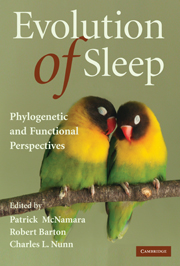Book contents
- Frontmatter
- Contents
- Contributors
- Acknowledgments
- Introduction
- 1 Ecological constraints on mammalian sleep architecture
- 2 Sleep in insects
- 3 Schooling by continuously active fishes: Clues to sleep's ultimate function
- 4 What exactly is it that sleeps? The evolution, regulation, and organization of an emergent network property
- 5 Evolutionary medicine of sleep disorders: Toward a science of sleep duration
- 6 Primate sleep in phylogenetic perspective
- 7 A bird's-eye view of the function of sleep
- 8 The evolution of wakefulness: From reptiles to mammals
- 9 The evolution of REM sleep
- 10 Toward an understanding of the function of sleep: New insights from mouse genetics
- 11 Fishing for sleep
- Index
- Plate section
- References
4 - What exactly is it that sleeps? The evolution, regulation, and organization of an emergent network property
Published online by Cambridge University Press: 10 March 2010
- Frontmatter
- Contents
- Contributors
- Acknowledgments
- Introduction
- 1 Ecological constraints on mammalian sleep architecture
- 2 Sleep in insects
- 3 Schooling by continuously active fishes: Clues to sleep's ultimate function
- 4 What exactly is it that sleeps? The evolution, regulation, and organization of an emergent network property
- 5 Evolutionary medicine of sleep disorders: Toward a science of sleep duration
- 6 Primate sleep in phylogenetic perspective
- 7 A bird's-eye view of the function of sleep
- 8 The evolution of wakefulness: From reptiles to mammals
- 9 The evolution of REM sleep
- 10 Toward an understanding of the function of sleep: New insights from mouse genetics
- 11 Fishing for sleep
- Index
- Plate section
- References
Summary
Abstract
It is posited that sleep is a network-emergent property of any viable group of interconnected neurons. Animals ranging from jellyfish to all homeotherms sleep. Biochemical sleep-regulatory events, including cytokines and nuclear factor kappa B (NF-kB), are shared by insects and mammals. It seems likely that these sleep-regulatory events evolved from metabolic-regulatory events and that sleep is a local use-dependent process. Relationships between sleep and tumor necrosis factor (TNF) are used to examine the local use-dependent sleep hypothesis. ATP released during neurotransmission is posited to drive the production and release of cytokines, such as TNF, that, in turn, act within a biochemical sleep homeostat in the short term – via adenosine, nitric oxide, and prostaglandins – to enhance non–rapid-eye-movement (NREM) sleep. In the long term, TNF and other sleep-regulatory substances, via NF-kB activation, enhance expression of receptors such as adenosine A1 and glutamate amino-3-hydroxy-5-methylisoxazoleproprionic (AMPA) receptors. Changes in the expression of these receptors will change the sensitivity of neurons and thereby change synaptic efficacy. Such actions suggest that sleep mechanisms cannot be separated from a connectivity function of sleep at the local network level. The need for sleep is derived from the experience-driven changes in neuronal microcircuitry that necessitate the stabilization of synaptic networks to maintain physiological regulatory networks and instinctual and acquired memories. The need for unconsciousness is derived from the local use-dependent sleep mechanisms.
- Type
- Chapter
- Information
- Evolution of SleepPhylogenetic and Functional Perspectives, pp. 86 - 106Publisher: Cambridge University PressPrint publication year: 2009



